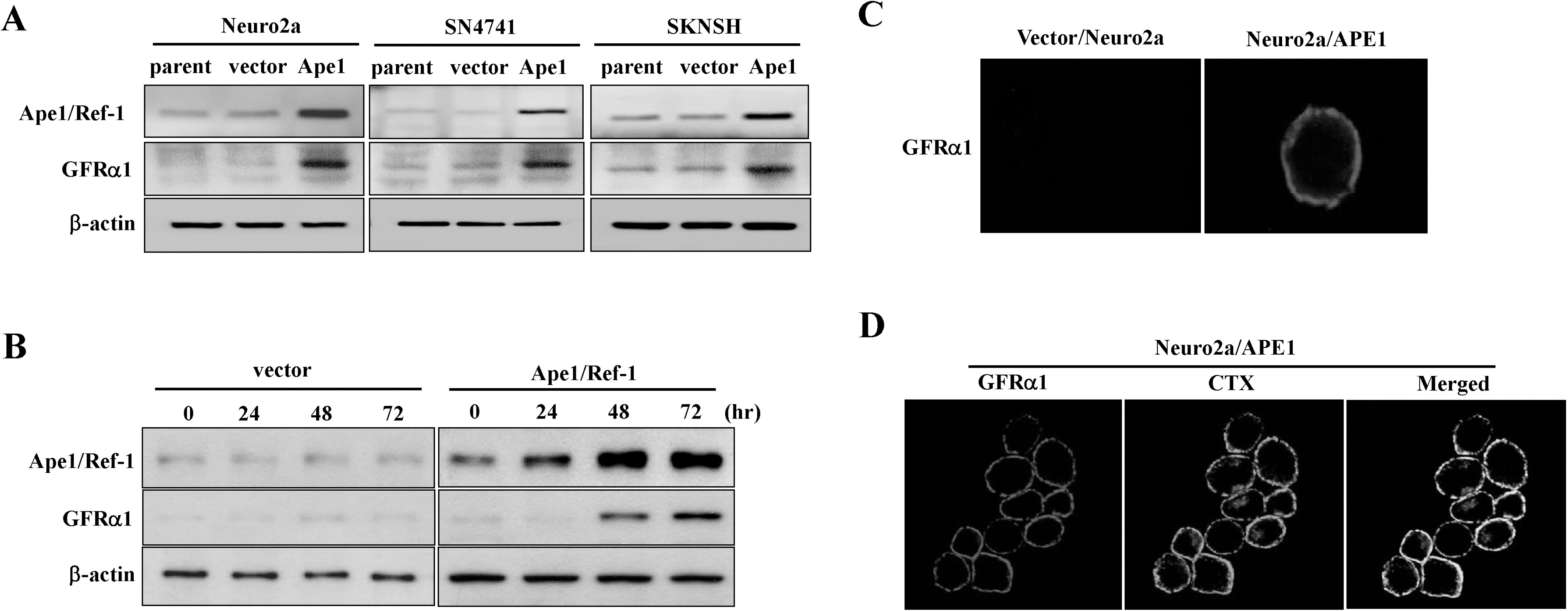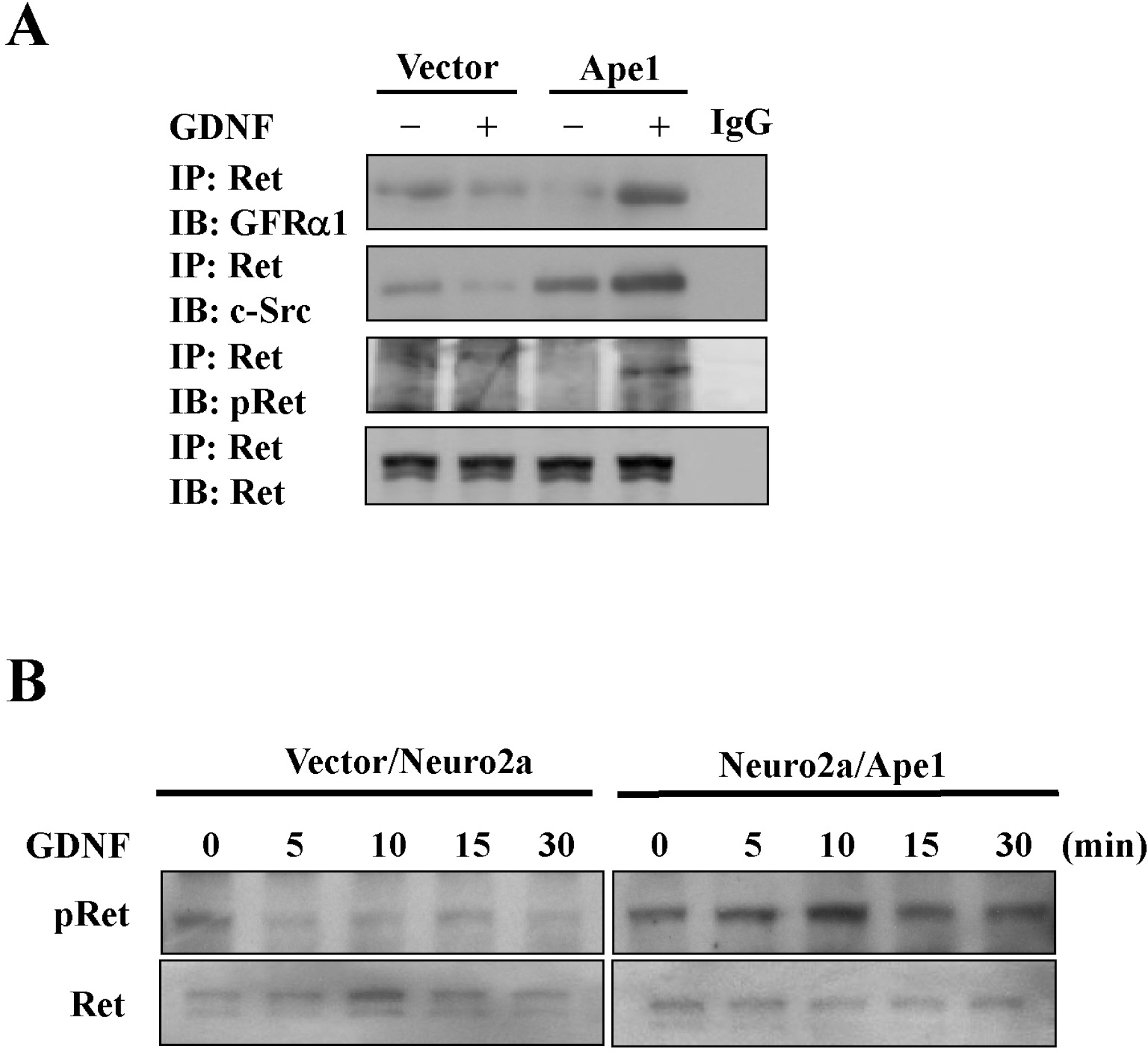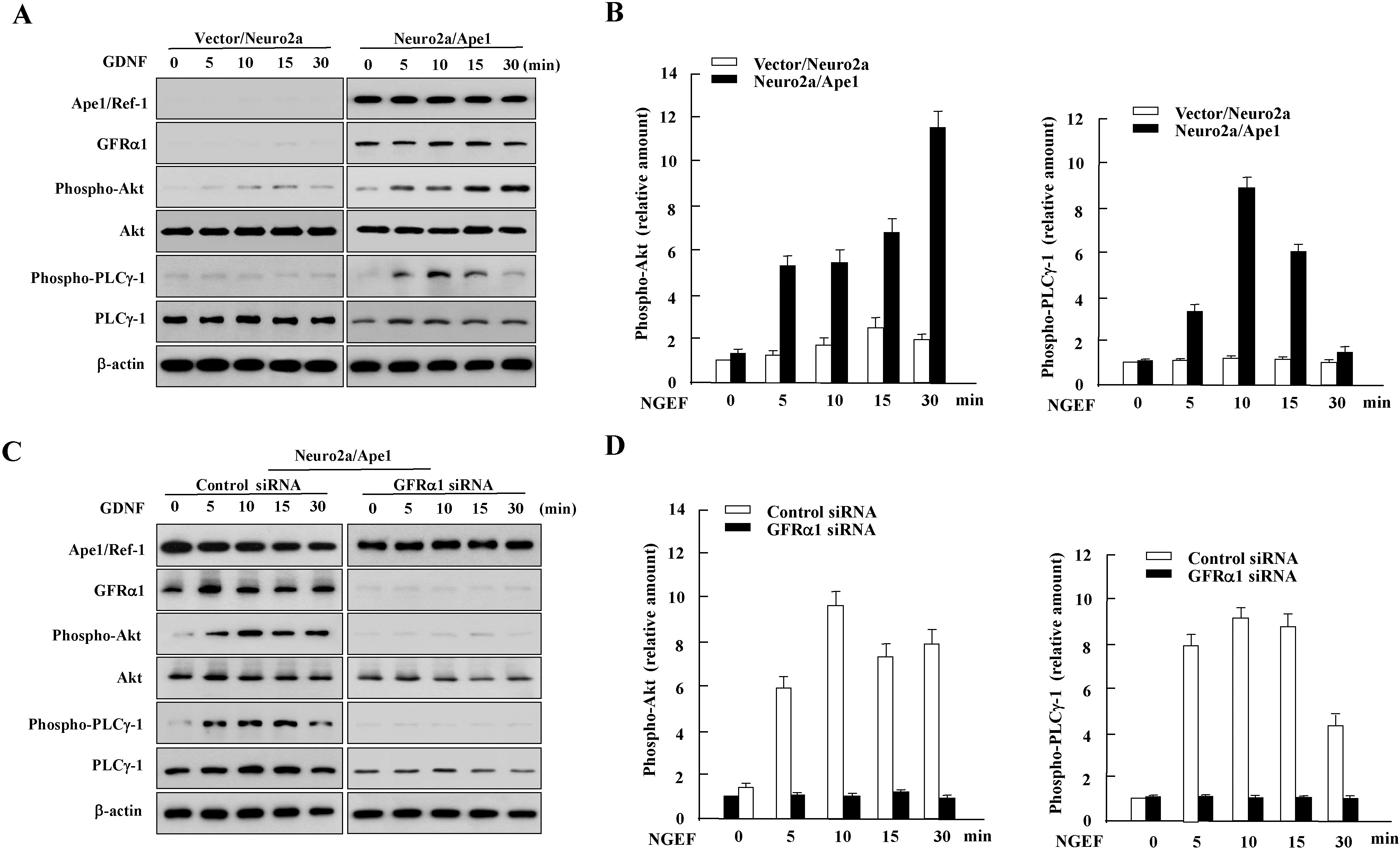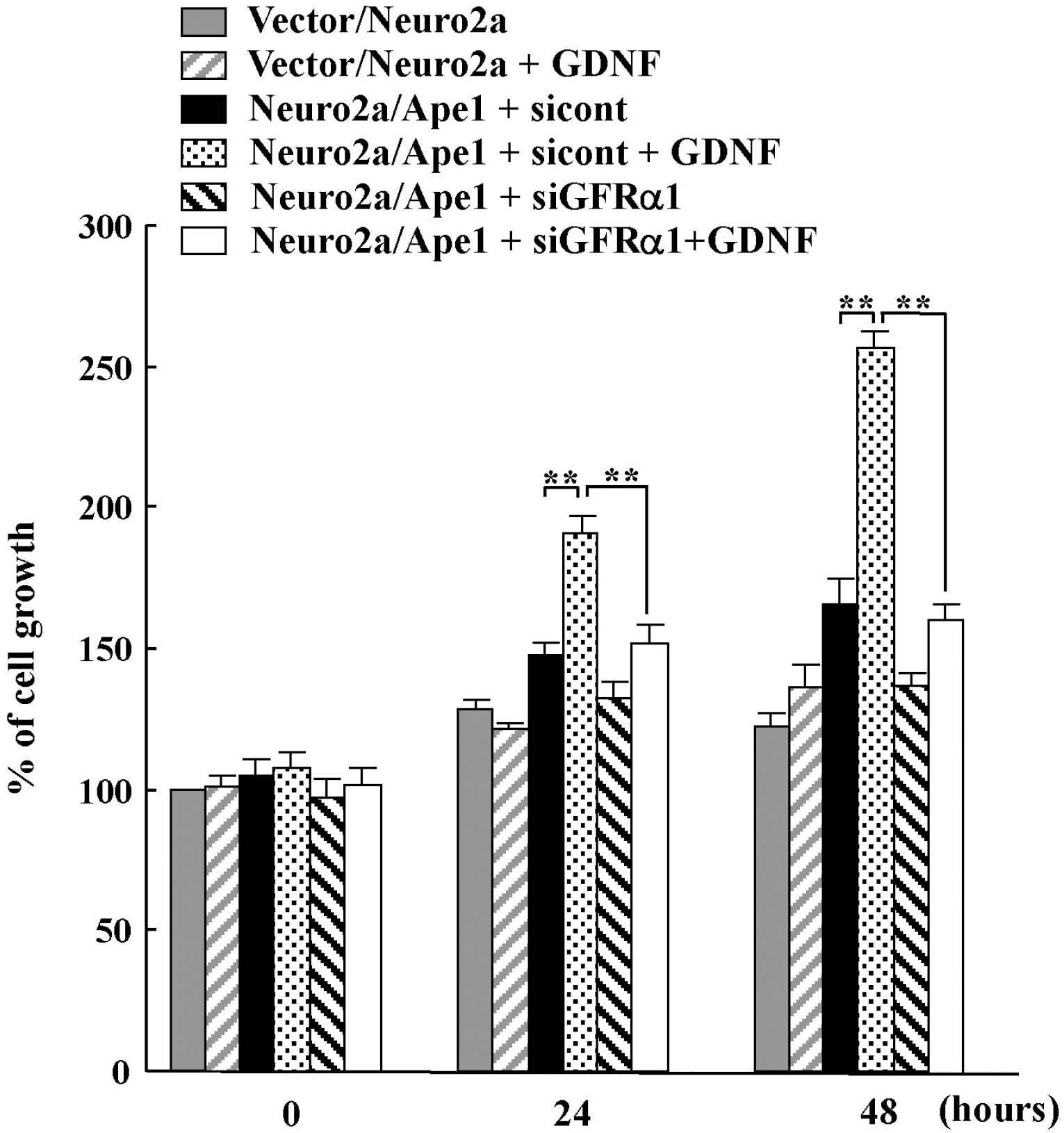Abstract
We previously reported that glial cell line-derived neurotropic factor (GDNF) receptor α1 (GFRα1) is a direct target of apurinic/apyrimidinic endonuclease 1 (Ape1/Ref-1). In the present study, we further analyzed the physiological roles of Ape1/Ref-1-induced GFRα1 expression in Neuro2a mouse neuroblastoma cells. Ape1/Ref-1 expression caused the clustering of GFRα1 immunoreactivity in lipid rafts in response to GDNF. We also found that Ret, a downstream target of GFRα1, was functionally activated by GDNF in Ape1/Ref-1-expressing cells. Moreover, GDNF promoted the proliferation of Ape1/Ref-1-expressing Neuro2a cells. Furthermore, GFRα1-specific RNA experiments demonstrated that the downregulation of GFRα1 by siRNA in Ape1/Ref-1-expressing cells impaired the ability of GDNF to phosphorylate Akt and PLCγ-1 and to stimulate cellular proliferation. These results show an association between Ape1/Ref-1 and GDNF/GFRα signaling, and suggest a potential molecular mechanism for the involvement of Ape1/Ref-1 in neuronal proliferation.
References
Airaksinen MS., Saarma M. The GDNF family: signalling, biological functions and therapeutic value. Nat Rev Neurosci. 3:383–394. 2002.

Airaksinen MS., Titievsky A., Saarma M. GDNF family neurotrophic factor signaling: four masters, one servant? Mol Cell Neurosci. 13:313–325. 1999.

Besset V., Scott RP., Ibanez CF. Signaling complexes and protein-protein interactions involved in the activation of the Ras and phosphatidylinositol 3-kinase pathways by the c-Ret receptor tyrosine kinase. J Biol Chem. 275:39159–39166. 2000.

Bobola MS., Finn LS., Ellenbogen RG., Geyer JR., Berger MS., Braga JM., Meade EH., Gross ME., Silber JR. Apurinic/apyrimidinic endonuclease activity is associated with response to radiation and chemotherapy in medulloblastoma and primitive neuroectodermal tumors. Clin Cancer Res. 11:7405–7414. 2005.

Borrello MG., Alberti L., Arighi E., Bongarzone I., Battistini C., Bardelli A., Pasini B., Piutti C., Rizzetti MG., Mondellini P., Radice MT., Pierotti MA. The full oncogenic activity of Ret/ptc2 depends on tyrosine 539, a docking site for phospholipase Cgamma. Mol Cell Biol. 16:2151–2163. 1996.

Cacalano G., Farinas I., Wang LC., Hagler K., Forgie A., Moore M., Armanini M., Phillips H., Ryan AM., Reichardt LF., Hynes M., Davies A., Rosenthal A. GFRalpha1 is an essential receptor component for GDNF in the developing nervous system and kidney. Neuron. 21:53–62. 1998.
Chattopadhyay R., Das S., Maiti AK., Boldogh I., Xie J., Hazra TK., Kohno K., Mitra S., Bhakat KK. Regulatory role of human AP-endonuclease (APE1/Ref-1) in YB-1-mediated activation of the multidrug resistance gene MDR1. Mol Cell Biol. 28:7066–7080. 2008.
Chiarini LB., Freitas FG., Petrs-Silva H., Linden R. Evidence that the bifunctional redox factor / AP endonuclease Ref-1 is an anti-apoptotic protein associated with differentiation in the developing retina. Cell Death Differ. 7:272–281. 2000.

Coulpier M., Anders J., Ibanez CF. Coordinated activation of autophosphorylation sites in the RET receptor tyrosine kinase: importance of tyrosine 1062 for GDNF mediated neuronal differentiation and survival. J Biol Chem. 277:1991–1999. 2002.
Durbec P., Marcos-Gutierrez CV., Kilkenny C., Grigoriou M., Wartiowaara K., Suvanto P., Smith D., Ponder B., Costantini F., Saarma M. GDNF signalling through the Ret receptor tyrosine kinase. Nature. 381:789–793. 1996.

Edwards M., Rassin DK., Izumi T., Mitra S., Perez-Polo JR. APE/Ref-1 responses to oxidative stress in aged rats. J Neurosci Res. 54:635–638. 1998.

Ernsberger U. The role of GDNF family ligand signalling in the differentiation of sympathetic and dorsal root ganglion neurons. Cell Tissue Res. 333:353–371. 2008.

Fantini D., Vascotto C., Deganuto M., Bivi N., Gustincich S., Marcon G., Quadrifoglio F., Damante G., Bhakat KK., Mitra S., Tell G. APE1/Ref-1 regulates PTEN expression mediated by Egr-1. Free Radic Res. 42:20–29. 2008.

Fishel ML., He Y., Reed AM., Chin-Sinex H., Hutchins GD., Mendonca MS., Kelley MR. Knockdown of the DNA repair and redox signaling protein Ape1/Ref-1 blocks ovarian cancer cell and tumor growth. DNA Repair (Amst). 7:177–186. 2008.

Fung H., Demple B. A vital role for Ape1/Ref1 protein in repairing spontaneous DNA damage in human cells. Mol Cell. 17:463–470. 2005.

Fung H., Liu P., Demple B. ATF4-dependent oxidative induction of the DNA repair enzyme Ape1 counteracts arsenite cytotoxicity and suppresses arsenite-mediated mutagenesis. Mol Cell Biol. 27:8834–8847. 2007.

Gash DM., Zhang Z., Ovadia A., Cass WA., Yi A., Simmerman L., Russell D., Martin D., Lapchak PA., Collins F., Hoffer BJ., Gerhardt GA. Functional recovery in parkinsonian monkeys treated with GDNF. Nature. 380:252–255. 1996.

Hong M., Mukhida K., Mendez I. GDNF therapy for Parkinson's disease. Expert Rev Neurother. 8:1125–1139. 2008.

Iwamori M., Shimomura J., Nagai Y. Specific binding of cholera toxin to rat erythrocytes revealed by analysis with a fluorescence-activated cell sorter. J Biochem. 97:729–735. 1985.
Jiang Y., Guo C., Vasko MR., Kelley MR. Implications of apurinic/apyrimidinic endonuclease in reactive oxygen signaling response after cisplatin treatment of dorsal root ganglion neurons. Cancer Res. 68:6425–6434. 2008.

Jing S., Wen D., Yu Y., Holst PL., Luo Y., Fang M., Tamir R., Antonio L., Hu Z., Cupples R., Louis JC., Hu S., Altrock BW., Fox GM. GDNF-induced activation of the ret protein tyrosine kinase is mediated by GDNFR-alpha, a novel receptor for GDNF. Cell. 85:1113–1124. 1996.
Kim MH., Kim HB., Acharya S., Sohn HM., Jun JY., Chang IY., You HJ. Ape1/Ref-1 induces glial cell-derived neurotropic factor (GDNF) responsiveness by upregulating GDNF receptor alpha1 expression. Mol Cell Biol. 29:2264–2277. 2009.
Kirik D., Georgievska B., Bjorklund A. Localized striatal delivery of GDNF as a treatment for Parkinson disease. Nat Neurosci. 7:105–110. 2004.

Kisby GE., Milne J., Sweatt C. Evidence of reduced DNA repair in amyotrophic lateral sclerosis brain tissue. Neuroreport. 8:1337–1340. 1997.

Klein SM., Behrstock S., McHugh J., Hoffmann K., Wallace K., Suzuki M., Aebischer P., Svendsen CN. GDNF delivery using human neural progenitor cells in a rat model of ALS. Hum Gene Ther. 16:509–521. 2005.

Larsen E., Meza TJ., Kleppa L., Klungland A. Organ and cell specificity of base excision repair mutants in mice. Mutat Res. 614:56–68. 2007.

Lewen A., Sugawara T., Gasche Y., Fujimura M., Chan PH. Oxidative cellular damage and the reduction of APE/Ref-1 expression after experimental traumatic brain injury. Neurobiol Dis. 8:380–390. 2001.
Lin LF., Doherty DH., Lile JD., Bektesh S., Collins F. GDNF: a glial cell line-derived neurotrophic factor for midbrain dopaminergic neurons. Science. 260:1130–1132. 1993.

Liu H., Colavitti R., Rovira II., Finkel T. Redox-dependent transcriptional regulation. Circ Res. 97:967–974. 2005.

McNeill DR., Lam W., DeWeese TL., Cheng YC., Wilson DM 3rd. Impairment of APE1 function enhances cellular sensitivity to clinically relevant alkylators and antimetabolites. Mol Cancer Res. 7:897–906. 2009.

McNeill DR., Wilson DM 3rd. A dominant-negative form of the major human abasic endonuclease enhances cellular sensitivity to laboratory and clinical DNA-damaging agents. Mol Cancer Res. 5:61–70. 2007.

Moore MW., Klein RD., Farinas I., Sauer H., Armanini M., Phillips H., Reichardt LF., Ryan AM., Carver-Moore K., Rosenthal A. Renal and neuronal abnormalities in mice lacking GDNF. Nature. 382:76–79. 1996.

Olkowski ZL. Mutant AP endonuclease in patients with amyotrophic lateral sclerosis. Neuroreport. 9:239–242. 1998.

Ono Y., Matsumoto K., Furuta T., Ohmoto T., Akiyama K., Seki S. Relationship between expression of a major apurinic/apyrimidinic endonuclease (APEX nuclease) and susceptibility to genotoxic agents in human glioma cell lines. J Neurooncol. 25:183–192. 1995.

Paratcha G., Ledda F. GDNF and GFRalpha: a versatile molecular complex for developing neurons. Trends Neurosci. 31:384–391. 2008.
Paratcha G., Ledda F., Baars L., Coulpier M., Besset V., Anders J., Scott R., Ibanez CF. Released GFRalpha1 potentiates downstream signaling, neuronal survival, and differentiation via a novel mechanism of recruitment of c-Ret to lipid rafts. Neuron. 29:171–184. 2001.
Pichel JG., Shen L., Sheng HZ., Granholm AC., Drago J., Grinberg A., Lee EJ., Huang SP., Saarma M., Hoffer BJ., Sariola H., Westphal H. Defects in enteric innervation and kidney development in mice lacking GDNF. Nature. 382:73–76. 1996.

Pong K., Xu RY., Baron WF., Louis JC., Beck KD. Inhibition of phosphatidylinositol 3-kinase activity blocks cellular differentiation mediated by glial cell line-derived neurotrophic factor in dopaminergic neurons. J Neurochem. 71:1912–1919. 1998.

Rass U., Ahel I., West SC. Defective DNA repair and neurodegenerative disease. Cell. 130:991–1004. 2007.

Saarma M., Sariola H. Other neurotrophic factors: glial cell line-derived neurotrophic factor (GDNF). Microsc Res Tech. 45:292–302. 1999.

Sakurai M., Nagata T., Abe K., Horinouchi T., Itoyama Y., Tabayashi K. Oxidative damage and reduction of redox factor-1 expression after transient spinal cord ischemia in rabbits. J Vasc Surg. 37:446–452. 2003.

Sanchez MP., Silos-Santiago I., Frisen J., He B., Lira SA., Barbacid M. Renal agenesis and the absence of enteric neurons in mice lacking GDNF. Nature. 382:70–73. 1996.

Sariola H., Saarma M. Novel functions and signalling pathways for GDNF. J Cell Sci. 116:3855–3862. 2003.

Tan Z., Sun N., Schreiber SS. Immunohistochemical localization of redox factor-1 (Ref-1) in Alzheimer's hippocampus. Neuroreport. 9:2749–2752. 1998.

Tansey MG., Baloh RH., Milbrandt J., Johnson EM. GFRalpha-mediated localization of RET to lipid rafts is required for effective downstream signaling, differentiation, and neuronal survival. Neuron. 25:611–623. 2000.
Tomac A., Lindqvist E., Lin LF., Ogren SO., Young D., Hoffer BJ., Olson L. Protection and repair of the nigrostriatal dopaminergic system by GDNF in vivo. Nature. 373:335–339. 1995.

Treanor JJ., Goodman L., de Sauvage F., Stone DM., Poulsen KT., Beck CD., Gray C., Armanini MP., Pollock RA., Hefti F., Phillips HS., Goddard A., Moore MW., Buj-Bello A., Davies AM., Asai N., Takahashi M., Vandlen R., Henderson CE., Rosenthal A. Characterization of a multicomponent receptor for GDNF. Nature. 382:80–83. 1996.

Tsui-Pierchala BA., Encinas M., Milbrandt J., Johnson EM. Lipid rafts in neuronal signaling and function. Trends Neurosci. 25:412–417. 2002.

Vasko MR., Guo C., Kelley MR. The multifunctional DNA repair/redox enzyme Ape1/Ref-1 promotes survival of neurons after oxidative stress. DNA Repair (Amst). 4:367–379. 2005.

Walton M., Lawlor P., Sirimanne E., Williams C., Gluckman P., Dragunow M. Loss of Ref-1 protein expression precedes DNA fragmentation in apoptotic neurons. Brain Res Mol Brain Res. 44:167–170. 1997.

Wang D., Luo M., Kelley MR. Human apurinic endonuclease 1 (APE1) expression and prognostic significance in osteosarcoma: enhanced sensitivity of osteosarcoma to DNA damaging agents using silencing RNA APE1 expression inhibition. Mol Cancer Ther. 3:679–686. 2004.
Wilson TM., Rivkees SA., Deutsch WA., Kelley MR. Differential expression of the apurinic / apyrimidinic endonuclease (APE/ref-1) multifunctional DNA base excision repair gene during fetal development and in adult rat brain and testis. Mutat Res. 362:237–248. 1996.
Xanthoudakis S., Curran T. Identification and characterization of Ref-1, a nuclear protein that facilitates AP-1 DNA-binding activity. Embo J. 11:653–665. 1992.

Xanthoudakis S., Smeyne RJ., Wallace JD., Curran T. The redox/DNA repair protein, Ref-1, is essential for early embryonic development in mice. Proc Natl Acad Sci USA. 93:8919–8923. 1996.

Fig. 1.
GFRα1 colocalizes with a lipid raft marker in Ape1/Ref-1-expressing Neuro2a cells. (A) Neuro2a, SN4741, and SKNSH cells were transfected with empty vector (vector) or Ape1/Ref-1 expression vector (Ape1) then harvested 48 h later. Total cell extracts were prepared for immunoblotting as indicated. (B) Neuro2a cells were transfected with empty or Ape1/Ref-1 expression vector and then harvested at the indicated times after transfection. Total cell extracts were prepared for immunoblotting as indicated. (C) Neuro2a/Ape1 and vector/Neuro2a cells were immunostained using polyclonal anti-GFRα1 antibodies tagged with Alexa fluor. (D) Neuro2a/Ape1 cells were stained with anti-GFRα1 antibodies and cholera toxin (CTX), which specifically binds the lipid raft ganglioside GM1. The images show the colocalization of GFRα1 and CTX.

Fig. 2.
The effect of Ape1/Ref-1 on GDNF/GFRα1 signaling in Neuro2a cells. (A) Vector/Neuro2a (vector) and Neuro2a/Ape1 (Ape1) cells were treated with or without 30 ng/ml GDNF for 10 min. The cells were then lysed and subjected to immunoprecipitation (IP) with anti-Ret antibodies and analyzed for GFRα1, c-Src, phospho-Ret (pRet), and Ret by immunoblotting. (B) Vector/Neuro2a and Neuro2a/Ape1 cells were incubated with or without 30 ng/ml GDNF. At the indicated times, cell extracts were prepared and examined for activated phospho-Ret by immunoblotting.

Fig. 3.
Ape1/Ref-1 increases Akt and PLCγ-1 phosphorylation in response to GDNF through GFRα1. (A) GDNF-induced Akt and PLCγ-1 phosphorylation in Ape1/Ref-1-expressing Neuro2a cells. Vector/Neuro2a and Neuro2a/Ape1 cells were incubated with or without 30 ng/ml GDNF for the indicated times and total cell extracts were prepared for immunoblotting as indicated. (B) The amounts of phospho-Akt and Phospho-PLCγ-1 were quantified by densitometry and corrected for the amount of Akt and PLCγ-1 in the corresponding lysate, rerspectively. Levels of phospho-Akt and phospho-PLCγ-1 are expressed relative to its level in non-NGEF-treated cells (0 min) transfected with control vector. The data shown are the means±S.D. from three separate experiments. (C) Neuro2a/Ape1 cells were transfected with control or GFRα1 siRNA. At 48 h after transfection, the cells were incubated with or without 30 ng/ml GDNF for the indicated times. Total cell lysates were prepared for immunoblotting as indicated. (D) The amounts of phospho-Akt and Phospho-PLCγ-1 were quantified by densitometry and corrected for the amount of Akt and PLCγ-1 in the corresponding lysate, respectively. Levels of phospho-Akt are expressed relative to its level in non-NGEF-treated cells (0 min) transfected with control siRNA. The data shown are the means±S.D. from three separate experiments.

Fig. 4.
Ape1/Ref-1 expression increases neuronal proliferation in response to GDNF. Vector/Neuro2a and Neuro2a/Ape1 cells were transfected with control (sicont) or GFRα1-siRNA (siGFRα1). At 24 h after transfection, the cells were incubated with or without 30 ng/ml GDNF for up to 48 h. The number of cells was then determined by counting every 24 h after GDNF treatment. Each value is the mean±S.D. from three separate experiments. ∗∗p<0.01.





 PDF
PDF ePub
ePub Citation
Citation Print
Print


 XML Download
XML Download